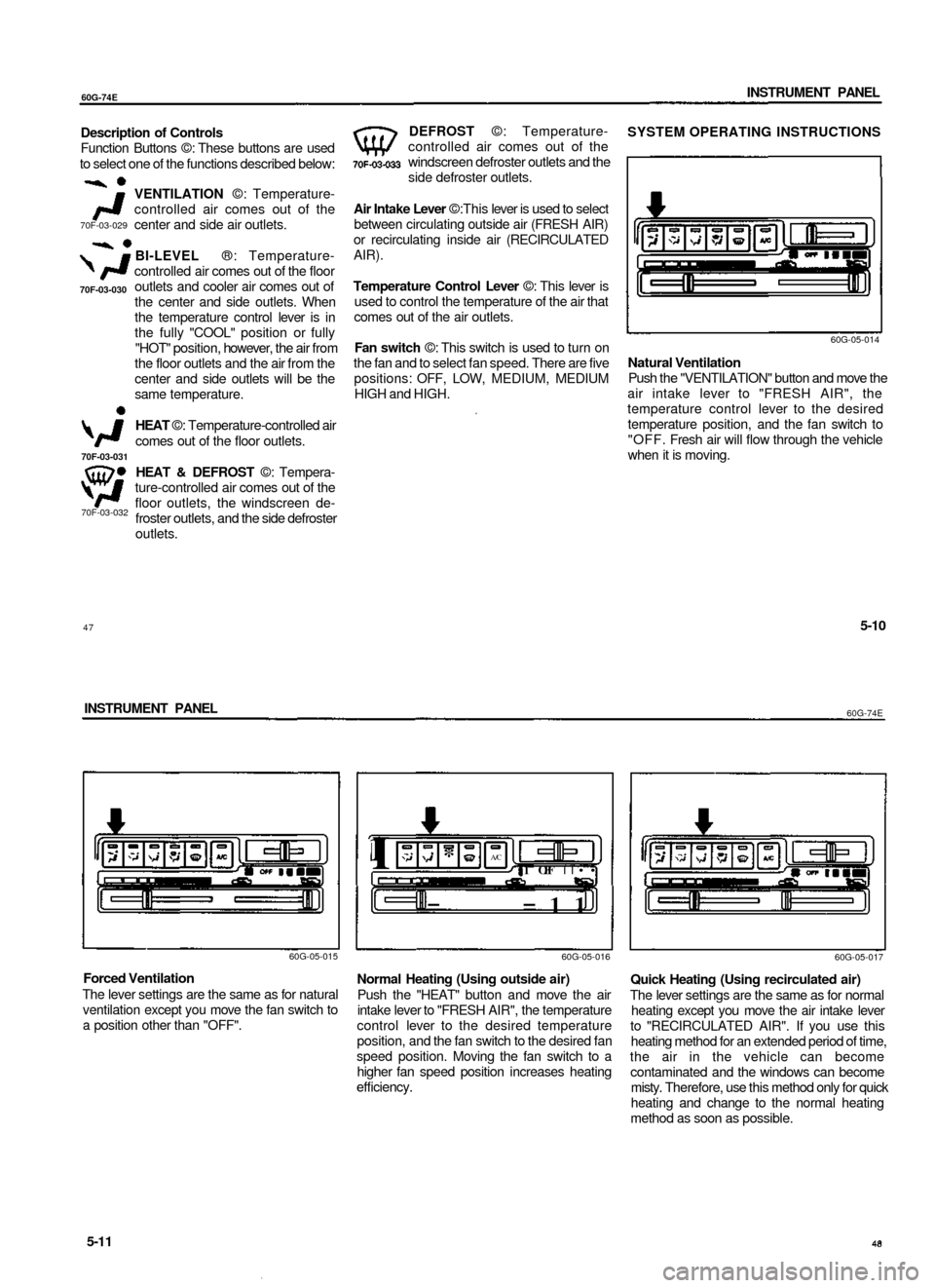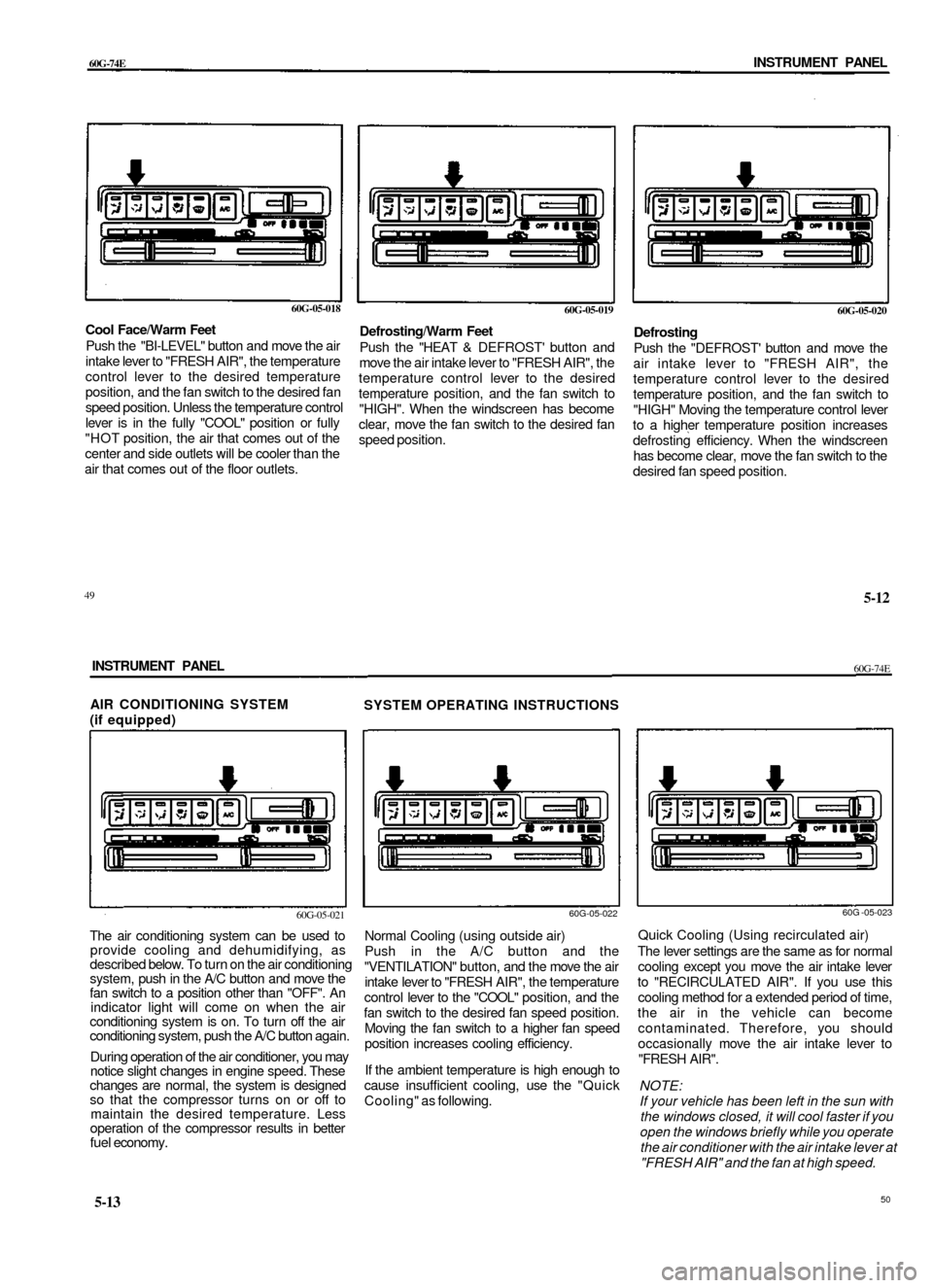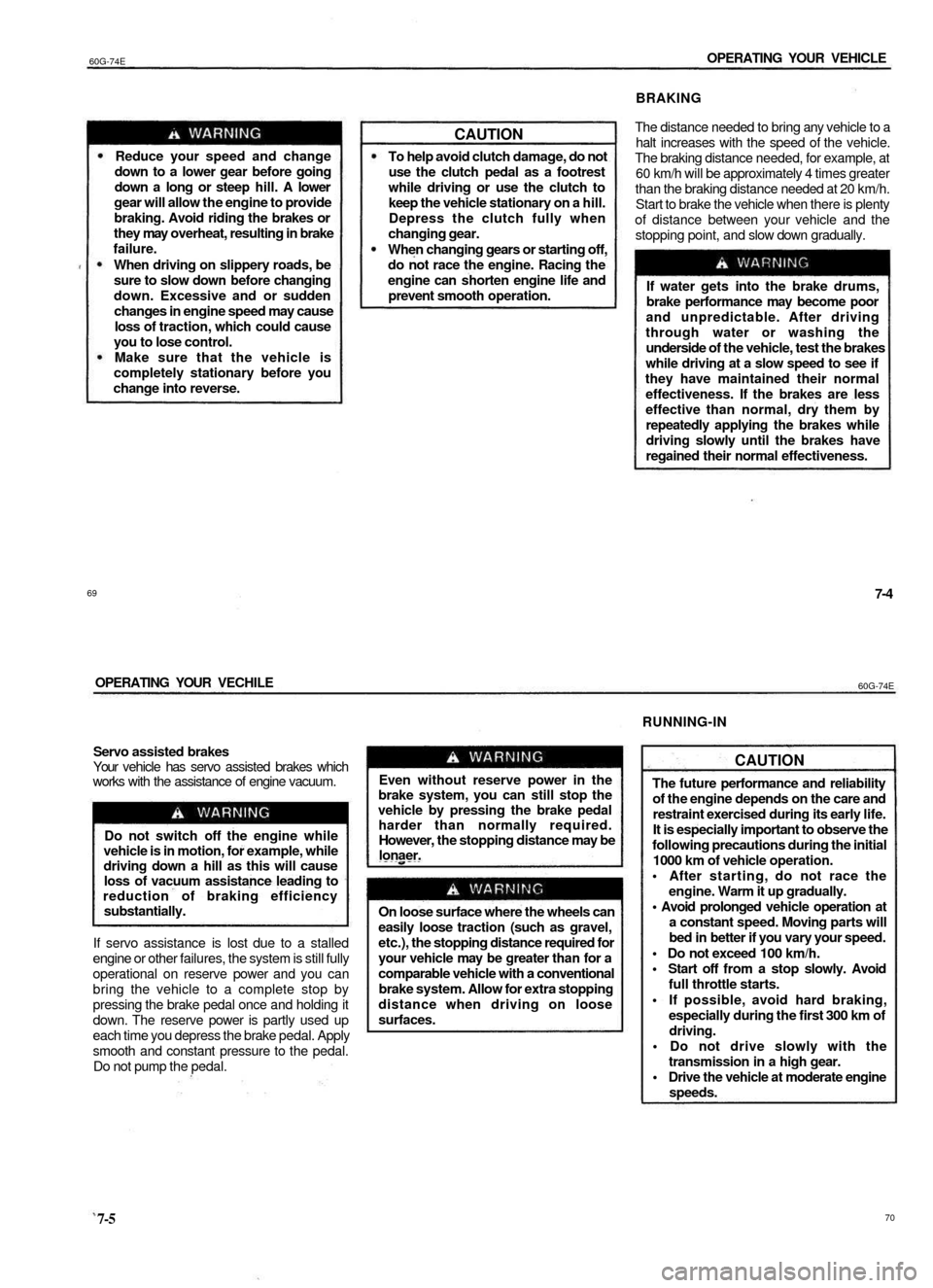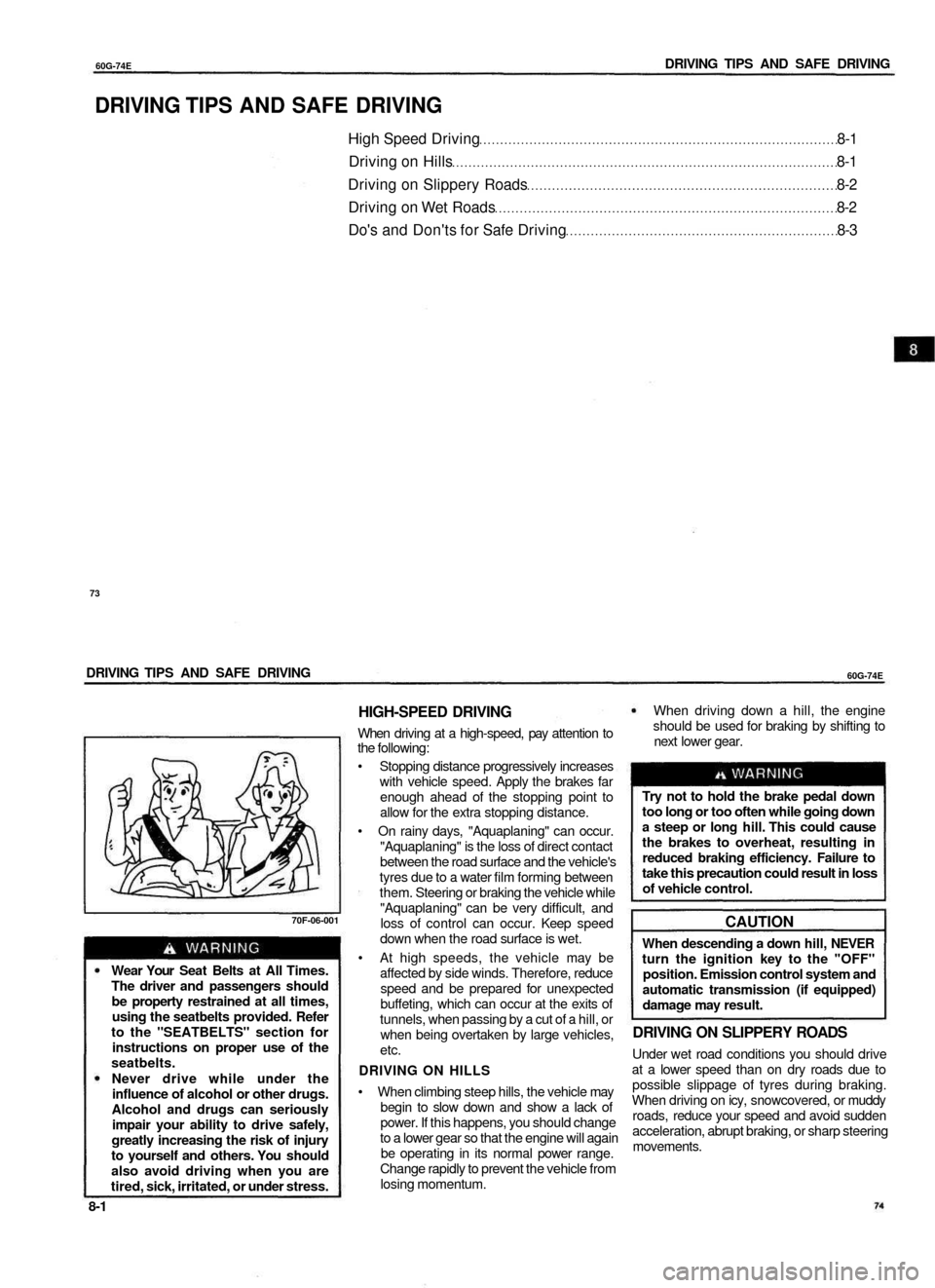1999 SUZUKI BALENO operating
[x] Cancel search: operatingPage 23 of 65

60G-74E
INSTRUMENT PANEL
Description of Controls
Function Buttons ©: These buttons are used
to select one of the functions described below:
VENTILATION ©: Temperature-
controlled air comes out of the
center and side air outlets.
BI-LEVEL ®: Temperature-
controlled air comes out of the floor
outlets and cooler air comes out of
the center and side outlets. When
the temperature control lever is in
the fully "COOL" position or fully
"HOT" position, however, the air from
the floor outlets and the air from the
center and side outlets will be the
same temperature.
HEAT ©: Temperature-controlled air
comes out of the floor outlets.
HEAT & DEFROST ©: Tempera-
ture-controlled air comes out of the
floor outlets, the windscreen de-
froster outlets, and the side defroster
outlets.
DEFROST ©: Temperature-
controlled air comes out of the
windscreen defroster outlets and the
side defroster outlets.
Air Intake Lever ©:This lever is used to select
between circulating outside air (FRESH AIR)
or recirculating inside air (RECIRCULATED
AIR).
Temperature Control Lever ©: This lever is
used to control the temperature of the air that
comes out of the air outlets.
Fan switch ©: This switch is used to turn on
the fan and to select fan speed. There are five
positions: OFF, LOW, MEDIUM, MEDIUM
HIGH and HIGH.
SYSTEM OPERATING INSTRUCTIONS
60G-05-014
Natural Ventilation
Push the "VENTILATION" button and move the
air intake lever to "FRESH AIR", the
temperature control lever to the desired
temperature position, and the fan switch to
"OFF. Fresh air will flow through the vehicle
when it is moving.
70F-03-032
47
5-10
INSTRUMENT PANEL
60G-74E
60G-05-015
Forced Ventilation
The lever settings are the same as for natural
ventilation except you move the fan switch to
a position other than "OFF".
1
I
*
A/C
1
OFF
| | ••
= =11
60G-05-016
Normal Heating (Using outside air)
Push the "HEAT" button and move the air
intake lever to "FRESH AIR", the temperature
control lever to the desired temperature
position, and the fan switch to the desired fan
speed position. Moving the fan switch to a
higher fan speed position increases heating
efficiency.
60G-05-017
Quick Heating (Using recirculated air)
The lever settings are the same as for normal
heating except you move the air intake lever
to "RECIRCULATED AIR". If you use this
heating method for an extended period of time,
the air in the vehicle can become
contaminated and the windows can become
misty. Therefore, use this method only for quick
heating and change to the normal heating
method as soon as possible.
5-11
70F-03-031
70F-03-030
70F-03-029
Page 24 of 65

60G-74E
INSTRUMENT PANEL
60G-05-018
Cool Face/Warm Feet
Push the "BI-LEVEL" button and move the air
intake lever to "FRESH AIR", the temperature
control lever to the desired temperature
position, and the fan switch to the desired fan
speed position. Unless the temperature control
lever is in the fully "COOL" position or fully
"HOT position, the air that comes out of the
center and side outlets will be cooler than the
air that comes out of the floor outlets.
60G-05-019
Defrosting/Warm Feet
Push the "HEAT & DEFROST' button and
move the air intake lever to "FRESH AIR", the
temperature control lever to the desired
temperature position, and the fan switch to
"HIGH". When the windscreen has become
clear, move the fan switch to the desired fan
speed position.
60G-05-020
Defrosting
Push the "DEFROST' button and move the
air intake lever to "FRESH AIR", the
temperature control lever to the desired
temperature position, and the fan switch to
"HIGH" Moving the temperature control lever
to a higher temperature position increases
defrosting efficiency. When the windscreen
has become clear, move the fan switch to the
desired fan speed position.
49
5-12
INSTRUMENT PANEL
60G-74E
AIR CONDITIONING SYSTEM
(if equipped)
SYSTEM OPERATING INSTRUCTIONS
60G-05-021
The air conditioning system can be used to
provide cooling and dehumidifying, as
described below. To turn on the air conditioning
system, push in the A/C button and move the
fan switch to a position other than "OFF". An
indicator light will come on when the air
conditioning system is on. To turn off the air
conditioning system, push the A/C button again.
During operation of the air conditioner, you may
notice slight changes in engine speed. These
changes are normal, the system is designed
so that the compressor turns on or off to
maintain the desired temperature. Less
operation of the compressor results in better
fuel economy.
60G-05-022
Normal Cooling (using outside air)
Push in the A/C button and the
"VENTILATION" button, and the move the air
intake lever to "FRESH AIR", the temperature
control lever to the "COOL" position, and the
fan switch to the desired fan speed position.
Moving the fan switch to a higher fan speed
position increases cooling efficiency.
If the ambient temperature is high enough to
cause insufficient cooling, use the "Quick
Cooling" as following.
60G -05-023
Quick Cooling (Using recirculated air)
The lever settings are the same as for normal
cooling except you move the air intake lever
to "RECIRCULATED AIR". If you use this
cooling method for a extended period of time,
the air in the vehicle can become
contaminated. Therefore, you should
occasionally move the air intake lever to
"FRESH AIR".
NOTE:
If your vehicle has been left in the sun with
the windows closed, it will cool faster if you
open the windows briefly while you operate
the air conditioner with the air intake lever at
"FRESH AIR" and the fan at high speed.
5-13
50
Page 27 of 65

OTHER CONTROLS AND EQUIPMENTS
60G-74E
PARKING BRAKE LEVER
63B-06-001E
The parking brake lever is located between
the seats. To apply the parking brake, hold the
brake pedal down and pull the parking brake
lever all the way up.
63B-06-002E
To release the parking brake, hold the brake
pedal down, pull up slightly on the parking
brake lever, push the button on the end of the
lever with your thumb, and lower the lever to
its original position.
Never drive your vehicle with the
parking brake on: rear brake
effectiveness can be reduced from
over heating, brake life may be
shortened, or permanent brake
damage may result.
If the parking brake does not hold
the vehicle securely or does not fully
release, have your vehicle inspected
immediately by an authorized
MARUTI dealer.
Always apply the parking brake fully
before leaving your vehicle or it may
move, causing injury or damage. When
parking, make sure the gear shift lever
is left in first gear or reverse.
Remember, even though the
transmission is in gear, you must
always apply the parking brake fully.
6-1
54
60G-74E
OTHER CONTROLS AND EQUIPMENT
PEDALS
GEAR LEVER
60G-06-001
Clutch Pedal ©
The clutch pedal is used to disengage the drive
to the wheels when starting the engine,
stopping, or shifting the transmission lever.
Depressing the pedal disengages the clutch.
CAUTION
Do not drive with your foot resting on
the clutch pedal. It could result in
excessive clutch wear, clutch damage,
or unexpected loss of engine braking.
Brake Pedal ®
Your MARUTI vehicle is equipped with front
disc brakes and rear drum brakes. Depressing
the brake pedal applies both sets of brakes.
You may hear occasional brake squeal when
you apply the brakes. This is a normal
condition caused by environmental factors
such as cold, wet, snow, etc.
If brake squeal is excessive and occurs
each time the brakes are applied, you
should have the brakes checked by
your MARUTI dealer.
A WARNING
Do not "ride" the brakes by applying
them continuously or resting your foot
on the pedal. This will result in
overheating of the brakes which could
cause unpredictable braking action,
longer stopping distances, or
permanent brake damage.
Accelerator Pedal ®
This pedal controls the speed of the engine.
Depressing the accelerator pedal increases
power output and speed.
70F-04-005E
The gear change pattern is shown in the
illustration. For details on how to use the
transmission, refer to USING THE
TRANSMISSION in the OPERATING YOUR
VEHICLE section.
55
6-2
Page 32 of 65

S0G-74E
OPERATING YOUR VEHICLE
OPERATING YOUR VEHICLE
Exhaust Gas Warning 7-1
Daily Inspection Checklist 7-1
Starting the Engine 7-2
Using the Transmission 7-3
Braking 7-4
Running-in 7-5
Catalytic Converter (if equipped) 7-6
Improving Fuel Economy 7-7
Trailer Towing 7-7
OPERATING YOUR VECHILE
60G-74E
EXHAUST GAS WARNING
DAILY INSPECTION CHECKLIST
60G-07-001E
Avoid breathing exhaust gases.
Exhaust gases contain carbon
monoxide, a potentially lethal gas that
is colourless and odourless. Since
carbon monoxide is difficult to detect
by itself, be sure to take the following
precautions to help prevent carbon
monoxide from entering your vehicle.
• Do not leave the engine running in
garages or other confined areas.
• Do not park with the engine running
for a long period of time, even in an
open area. If it is necessary to sit for
a short time in a parked vehicle <=>
with the engine running, make sure
the air intake lever is set to "FRESH
AIR" and the fan is at high speed.
To allow proper operation of your
vehicle's ventilation system, keep
the air inlet grille in front of the
windscreen clear of snow, leaves, or
other obstructions at all times.
Keep the exhaust tailpipe area clear
of snow and other material to help
reduce the buildup of exhaust gases
under the vehicle.This is particularly
important when parked in blizzard
conditions.
Have the exhaust system inspected
periodically for damage and leaks.
Any damage or leaks should be
repaired immediately.
7-1
70F-05-007
Before driving:
1) Make sure that windows, mirrors, lights,
and reflectors are clean and unobstructed.
2) Check the tyres.
3) Look for fluid and oil leaks.
NOTE:
It is normal for water to drip from the air
conditioning system after use.
4) Adjust the seat/head restraint.
5) Check the brake pedal and the parking
brake lever.
6) Adjust the mirrors.
7) Make sure that you and passengers have
properly fastened your seat belts.
8) Make sure that all warning lights come on
as the key is turned to the "ON" or "START'
position.
9) Check all gauges.
10) Make sure that the brake fluid level
warning light is off when the parking brake
is released with the ignition switch in "ON"
position.
66
65
Page 33 of 65

60G-74E
OPERATING YOUR VEHICLE
Once a week, or each time you fill your fuel
tank, perform the following under-bonnet
checks:
1) Engine oil level.
2) Coolant level.
3) Brake fluid level.
4) Power steering (if equipped) fluid level.
5) Windscreen washer fluid level.
6) Battery solution level.
7) Bonnet latch operation.
Pull the bonnet release handle inside the
vehicle. Make sure that you can not open
the hood all the way without releasing the
secondary latch. Be sure to close the hood
securely after checking for proper
operation. See "All Latches, Hinges &
Locks" of "PERIODIC MAINTENANCE
SCHEDULE" in the "INSPECTION AND
MAINTENANCE" section for lubrication
schedule.
Make sure the bonnet is fully closed
and latched before driving. If it is not,
it can fly up unexpectedly during
driving, obstructing your view and
resulting in an accident.
STARTING THE ENGINE
Before starting the engine:
1) Make sure the parking brake is applied
fully.
2) Manual Transmission - Shift into "N"
(neutral) and depress the clutch pedal all
the way to the floor. Hold it while starting
the engine.
Make sure that the parking brake is
applied fully and the transmission is in
Neutral before attempting to start the
engine.
CAUTION
Stop turning the starter immediately
after the engine has started or the
starter system can be damaged.
Do not crank the engine for more
than 15 seconds at a time. If the
engine doesn't start on the first try,
wait about 15 seconds before trying
again.
Starting a Cold Engine
Engine which is started after 6 hours should
be treated as cold engine.
For Electronic fuel injection models
• With your foot off the accelerator pedal,
crank the engine by turning the ignition
key to "START1. Release the key when the
engine starts.
• If the engine does not start after 15
seconds of cranking, wait about 15
seconds, then press down the accelerator
pedal to 1/3 of its travel and try cranking
the engine again. Release the key and
accelerator pedal when the engine starts.
• If the engine still does not start, try holding
the accelerator pedal all the way to the
floor while cranking. This should clear the
engine if it is flooded.
Starting a Warm Engine
For Electronic fuel injection models:
Use the same procedure as for "Starting a cold
Engine".
67
7-2
OPERATING YOUR VECHILE
60G-74E
USING THE TRANSMISSION
70F-04-005E
Starting off
To start off, depress and maintain pressure
upon the clutch pedal and change into 1st
gear. After releasing the parking brake,
gradually release the clutch. When you hear
a change in the engine's sound (speed), gently
apply pressure to the accelerator to keep the
engine sound (speed) constant whilst
continuing to gradually release the clutch.
Gear changing
All forward gears are synchronized, which
provides for quiet, easy changing. Always
depress the clutch pedal fully before changing
gears.The following table shows the maximum
allowable speed for each gear.
GEAR
First
Second
Third
Fourth
Fifth
MAXIMUM SPEED
50 km/h
95 km/h
140 km/h
Top Speed
Top Speed
7-3
68
Page 34 of 65

60G-74E
OPERATING YOUR VEHICLE
Reduce your speed and change
down to a lower gear before going
down a long or steep hill. A lower
gear will allow the engine to provide
braking. Avoid riding the brakes or
they may overheat, resulting in brake
failure.
When driving on slippery roads, be
sure to slow down before changing
down. Excessive and or sudden
changes in engine speed may cause
loss of traction, which could cause
you to lose control.
Make sure that the vehicle is
completely stationary before you
change into reverse.
CAUTION
To help avoid clutch damage, do not
use the clutch pedal as a footrest
while driving or use the clutch to
keep the vehicle stationary on a hill.
Depress the clutch fully when
changing gear.
When changing gears or starting off,
do not race the engine. Racing the
engine can shorten engine life and
prevent smooth operation.
BRAKING
The distance needed to bring any vehicle to a
halt increases with the speed of the vehicle.
The braking distance needed, for example, at
60 km/h will be approximately 4 times greater
than the braking distance needed at 20 km/h.
Start to brake the vehicle when there is plenty
of distance between your vehicle and the
stopping point, and slow down gradually.
69
7-4
OPERATING YOUR VECHILE
60G-74E
RUNNING-IN
Servo assisted brakes
Your vehicle has servo assisted brakes which
works with the assistance of engine vacuum.
Do not switch off the engine while
vehicle is in motion, for example, while
driving down a hill as this will cause
loss of vacuum assistance leading to
reduction of braking efficiency
substantially.
If servo assistance is lost due to a stalled
engine or other failures, the system is still fully
operational on reserve power and you can
bring the vehicle to a complete stop by
pressing the brake pedal once and holding it
down. The reserve power is partly used up
each time you depress the brake pedal. Apply
smooth and constant pressure to the pedal.
Do not pump the pedal.
Even without reserve power in the
brake system, you can still stop the
vehicle by pressing the brake pedal
harder than normally required.
However, the stopping distance may be
lonaer.
On loose surface where the wheels can
easily loose traction (such as gravel,
etc.), the stopping distance required for
your vehicle may be greater than for a
comparable vehicle with a conventional
brake system. Allow for extra stopping
distance when driving on loose
surfaces.
CAUTION
The future performance and reliability
of the engine depends on the care and
restraint exercised during its early life.
It is especially important to observe the
following precautions during the initial
1000 km of vehicle operation.
• After starting, do not race the
engine. Warm it up gradually.
• Avoid prolonged vehicle operation at
a constant speed. Moving parts will
bed in better if you vary your speed.
• Do not exceed 100 km/h.
• Start off from a stop slowly. Avoid
full throttle starts.
• If possible, avoid hard braking,
especially during the first 300 km of
driving.
• Do not drive slowly with the
transmission in a high gear.
• Drive the vehicle at moderate engine
speeds.
7-5
70
If water gets into the brake drums,
brake performance may become poor
and unpredictable. After driving
through water or washing the
underside of the vehicle, test the brakes
while driving at a slow speed to see if
they have maintained their normal
effectiveness. If the brakes are less
effective than normal, dry them by
repeatedly applying the brakes while
driving slowly until the brakes have
regained their normal effectiveness.
Page 35 of 65

60G-74E
OPERATING YOUR VEHICLE
CATALYTIC CONVERTER
(if equipped)
70F-05-005
The purpose of the catalytic converter installed
on your vehicle is to convert exhaust pollutants
to harmless water vapour, carbon dioxide, and
nitrogen. Use of leaded fuel in vehicles
equipped with catalytic converters is
prohibited, because lead deactivates the
pollutant-reducing components of the catalyst
system.
It is very important to keep the engine properly
tuned. Engine misfiring, which can result from
an improperly tuned engine, may cause
overheating of the catalyst. This may result in
permanent heat damage to the catalyst and
other vehicle components.
CAUTION
To minimize the possibility of catalyst
or other vehicle damage:
• Maintain the engine in the proper
operating condition.
• In the event of an engine
malfunction, particularly one
involving engine misfire or other
apparent loss of performance, have
the vehicle serviced promptly.
• Do not turn off the engine or
interrupt the ignition when the
transmission is in gear and the
vehicle is in motion.
• Do not try to start the engine by
pushing or towing the vehicle, or
coasting down a hill.
• Do not idle the engine with any spark
plug wires disconnected or
removed, such as during diagnostic
testing.
• Do not idle the vehicle for prolonged
periods if idling seems rough or
there are other malfunctions.
• Do not allow the fuel tank to get near
the empty level.
60Q-07-002E
Be careful where you park and drive;
the catalytic converter and other
exhaust components can get very hot.
As with any vehicle, do not park or
operate this vehicle in areas where
combustible materials such as dry
grass or leaves can come in contact
with a hot exhaust system.
7-6
OPERATING YOUR VECHILE
60G-74E
IMPROVING FUEL ECONOMY
The following instructions will help you improve
fuel economy.
Avoid excessive idling:
If you are to wait for more than a minute while
you are parked, stop the engine and start it
again later. When warming up a cold engine,
allow the engine to idle until the temperature
gauge pointer comes up to the "C" position. In
this position, the engine is sufficiently warm
for starting off.
Avoid "fast" starts:
Fast starts away from lights or stop signs will
consume fuel unnecessarily and shorten
engine life. Start off slowly.
Avoid unnecessary stops:
Avoid unnecessary deceleration and stopping.
Try to maintain a slow, steady speed whenever
possible. Slowing down and then accelerating
again uses more fuel.
Keep a steady cruising speed:
Keep as constant a speed as road and traffic
conditions will permit.
Air Outlet side
(Facing up)
60G-09-010
Keep the air cleaner clean:
A dirty air cleaner will cause the carburation
system to supply too much fuel to the engine
for the amount of air being supplied. The result
is waste of fuel due to incomplete combustion.
Keep weight to a minimum:
The heavier the load, the more fuel the vehicle
consumes. Take out any luggage or cargo
when it is not necessary.
Keep tyre pressures correct:
Under-inflation of the tyres can waste fuel due
to increased running resistance of the tyres.
Keep your tyres inflated to the correct pressure
shown on the label on the driver's side door
or door lock pillar.
TRAILER TOWING
Your MARUTI was originally designed to carry
people and a normal amount of cargo, not to
tow a trailer. Maruti does not recommend you
use your vehicle to tow a trailer.Towing a trailer
can adversely affect handling, durability, and
fuel economy.
7-7
72
71
Page 36 of 65

60G-74E
DRIVING TIPS AND SAFE DRIVING
DRIVING TIPS AND SAFE DRIVING
High Speed Driving 8-1
Driving on Hills 8-1
Driving on Slippery Roads 8-2
Driving on Wet Roads 8-2
Do's and Don'ts for Safe Driving 8-3
73
DRIVING TIPS AND SAFE DRIVING
60G-74E
70F-06-001
Wear Your Seat Belts at All Times.
The driver and passengers should
be property restrained at all times,
using the seatbelts provided. Refer
to the "SEATBELTS" section for
instructions on proper use of the
seatbelts.
Never drive while under the
influence of alcohol or other drugs.
Alcohol and drugs can seriously
impair your ability to drive safely,
greatly increasing the risk of injury
to yourself and others. You should
also avoid driving when you are
tired, sick, irritated, or under stress.
HIGH-SPEED DRIVING
When driving at a high-speed, pay attention to
the following:
• Stopping distance progressively increases
with vehicle speed. Apply the brakes far
enough ahead of the stopping point to
allow for the extra stopping distance.
• On rainy days, "Aquaplaning" can occur.
"Aquaplaning" is the loss of direct contact
between the road surface and the vehicle's
tyres due to a water film forming between
them. Steering or braking the vehicle while
"Aquaplaning" can be very difficult, and
loss of control can occur. Keep speed
down when the road surface is wet.
• At high speeds, the vehicle may be
affected by side winds. Therefore, reduce
speed and be prepared for unexpected
buffeting, which can occur at the exits of
tunnels, when passing by a cut of a hill, or
when being overtaken by large vehicles,
etc.
DRIVING ON HILLS
• When climbing steep hills, the vehicle may
begin to slow down and show a lack of
power. If this happens, you should change
to a lower gear so that the engine will again
be operating in its normal power range.
Change rapidly to prevent the vehicle from
losing momentum.
When driving down a hill, the engine
should be used for braking by shifting to
next lower gear.
Try not to hold the brake pedal down
too long or too often while going down
a steep or long hill. This could cause
the brakes to overheat, resulting in
reduced braking efficiency. Failure to
take this precaution could result in loss
of vehicle control.
CAUTION
When descending a down hill, NEVER
turn the ignition key to the "OFF"
position. Emission control system and
automatic transmission (if equipped)
damage may result.
DRIVING ON SLIPPERY ROADS
Under wet road conditions you should drive
at a lower speed than on dry roads due to
possible slippage of tyres during braking.
When driving on icy, snowcovered, or muddy
roads, reduce your speed and avoid sudden
acceleration, abrupt braking, or sharp steering
movements.
8-1